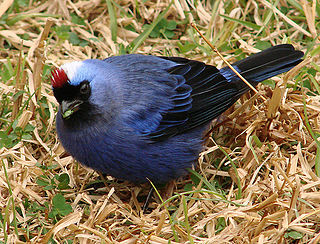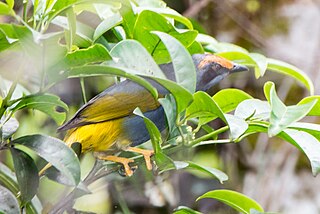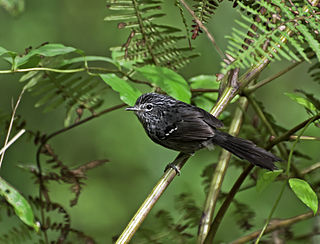
The forktails are small insectivorous birds in the genus Enicurus. They were formerly placed in the thrush family, Turdidae, but are now treated as part of the Old World flycatcher family, Muscicapidae. Their common name derives from their long forked tail.

The crested goshawk is a bird of prey in the family Accipitridae that is widely distributed in tropical Asia. It was formerly placed in the genus Accipiter.

The blackstart is a chat found in desert regions in North Africa, the Middle East and the Arabian Peninsula. It is resident throughout its range.

The African pygmy kingfisher is a small insectivorous kingfisher found in the Afrotropics, mostly in woodland habitats.

The Temminck's tragopan is a medium-sized, approximately 64 cm long, pheasant in the genus Tragopan. The male is a stocky red-and-orange bird with white-spotted plumage, black bill and pink legs. The male's display features include bare blue facial skin, inflatable dark-blue lappet and horns. The females are a white-spotted brown with blue circular eye skin.

The crested kingfisher is a very large kingfisher that is native to parts of southern Asia, stretching eastwards from the Indian Subcontinent towards Japan. It forms a species complex with the other three Megaceryle species.

The diademed tanager is a species of Neotropical bird in the tanager family Thraupidae. It is the only member of the genus Stephanophorus. It is purple-blue with a white crown characterised by a small red patch, and it is found mostly in open areas in southern Brazil, northeast Argentina, and Uruguay.

The scissor-tailed kite, also known as African swallow-tailed kite or fork-tailed kite, is a bird of prey in the family Accipitridae. It is the only species placed in the genus Chelictinia. It is widespread in the northern tropics of Africa.

The lesser noddy, also known as the sooty noddy, is a seabird in the family Laridae. It is found near the coastlines of Comoros, Kenya, India, Maldives, Mauritius, Seychelles, Somalia, Sri Lanka and United Arab Emirates.

The fiery-browed starling or fiery-browed myna is a species of starling in the family Sturnidae. It is monotypic within the genus Enodes. Distinguished by a reddish-orange stripe over the eye, it is endemic to the Indonesian island of Sulawesi, mainly living in humid highland forest.

The Javan blue-banded kingfisher, is a species of kingfisher in the subfamily Alcedininae. It is endemic to and found throughout Java, but is thought to be extremely rare due to human pressures such as habitat destruction. Its natural habitats are subtropical or tropical moist lowland forest, subtropical or tropical mangrove forest, and rivers. Its population is estimated to be just 50-249 individuals, and is believed to be in decline.

The little kingfisher is a species of kingfisher in the subfamily Alcedininae.

The purple-winged roller is a species of bird in the family Coraciidae. It is endemic to the Sulawesi subregion in Indonesia and can be found on the islands of Sulawesi, Bangka, Lembeh, Manterawu, Muna and Butung.

The tawny-headed swallow is a species of bird in the family Hirundinidae. It is the only species placed in the genus Alopochelidon. It is found in Argentina, Bolivia, Brazil, Colombia, Falkland Islands, Paraguay, Peru, Uruguay, and Venezuela, where its natural habitats are dry savanna and subtropical or tropical seasonally wet or flooded lowland grassland.

The black-masked finch is a species of South American bird in the tanager family Thraupidae. It is the only member of the genus Coryphaspiza. It is found in Argentina, Bolivia, Brazil, Paraguay, and Peru. Its natural habitats are subtropical or tropical moist shrubland, subtropical or tropical dry lowland grassland, and subtropical or tropical seasonally wet or flooded lowland grassland. It is threatened by habitat loss.

The dusky-tailed antbird is an insectivorous bird in subfamily Thamnophilinae of family Thamnophilidae, the "typical antbirds". It is found in Argentina, Brazil, and Paraguay.

The Sunda forktail is a species of bird in the family Muscicapidae. It is endemic to Indonesia, where it is restricted to the islands of Java and Sumatra. Its natural habitat is boulder strewn streams in tropical moist montane forest from 600–2000 m. More rarely the species occurs closer to sea level. The species is common in Sumatra, but is rarer in Java, where the white-crowned forktail is more common.

The elegant pitta is a species of passerine bird in the pitta family Pittidae. It is endemic to Indonesia, where it is found in the Lesser Sunda Islands and Moluccas.

The tree kingfishers, also called wood kingfishers or Halcyoninae, are the most numerous of the three subfamilies of birds in the kingfisher family, with around 70 species divided into 12 genera, including several species of kookaburras. The subfamily appears to have arisen in Indochina and Maritime Southeast Asia and then spread to many areas around the world. Tree kingfishers are widespread through Asia and Australasia, but also appear in Africa and the islands of the Pacific and Indian Oceans, using a range of habitats from tropical rainforest to open woodlands.
The Sangihe lilac kingfisher is a species of kingfisher in the genus Cittura, endemic to the lowlands of the Indonesian island of Sangihe. It was previously considered a subspecies of the Sulawesi lilac kingfisher, but was split as a distinct species by the IUCN Red List and BirdLife International in 2014, and the International Ornithological Congress and Clements followed suit in 2022.

























